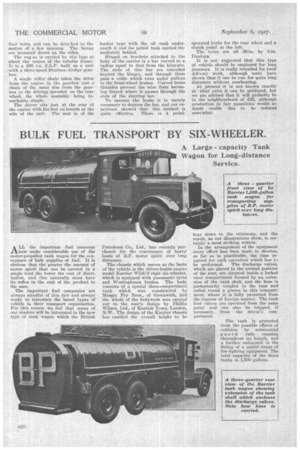A PROMISING LIGHT PARCELCAR.
Page 43

Page 44

If you've noticed an error in this article please click here to report it so we can fix it.
Details of a Simple and Efficient Machine to Carry 4 Cwt. It Embodies a 500 c.c. Engine and Three-speed Gear.
DL'IZING November of last year we published an editorial with a view to stimulating designer's into producing simple and efficient types of parcelcar ' to carry up to, .say, 5 cwt. of useful load. Such vehicles are performing most satisfactorily in many Continental cities, particularly in Germany, This would appear to be proof that the parcelcar can be run really economically, and we are convinced that, prer.uerly exploited, there should be a really important field for it in our own country.
We are glad to note that there are indications of an increasing interest being taken in this sphere of transport. For instance, G.N., Ltd., was struck by the potentialitieS of this type of machine and produced a small number for its own use, actually running examples for over 5,000 miles, a recent run being from London to the Midlands and back at an average SPeed of 20 m.p.h., carrying in each direction a 15.9 h.p. power unit complete with its gearbox.
The company has satisfied itself that the model produced is a good one and it is in touch with several large firms likely to favour the employment of such vehicles, and these have already his
played considerable interest in the design. It will s00.11 be building several more of the type for its own use and would be prepared to build for sale if desired, production on a larger scale naturally depending upon its popularity.
We understanC that all the stands have now been booked up at the Commercial Vehicle Exhibition at Olympia, so that it will not be possible to exhibit there, but those interested can make arrangements to see it at the works of G.N., Ltd., East Hill, Wandsworth, London, S.W.18,
We had a short trial run in the carrier of the machine, for which purpose' the lid was detached, and we made ourselves as comfortable as possible on ear cushions. 4 speed of 85 m.p.h. was reached, and a, long hill with a fairly severe gradient was climbed at a good pace on top gear. We were surprised at the excellent springing of the carrier and the steadiness and general ease of
control-of the parcelcar as a whole.
The design is as simple as it we'll Could be. The main frame consists of two 11--in, solid-drawn steel ,tubes of S s.vv.a. effectively strengthened with liners at each end, these tubes being inswept at the front, where they are bolted to a stout sblock surrounding what may be termed the king-pin of the carrier portion of the machine. At the rear the tubes are upswept to take the standard heavy motorcycle-type axle of
the single driving wheel. In the .exPerimental model no adjustment is provided for the -chain, but this will be provided for if the vehicle gees into production.
The frame of the carrier portion is built up on wide channel steel members with an extra-stout channel cross-member which serves to carry the king-pin.
The carrier is hold to its frame by four bolts, and can be detached in the matter of a few minutes. The lamps are mounted direct on the sides.
The eng:tie is carried by clip lugs at about the centre of the tubular frame. It is a 500 c.c. J.A.P. built as a unit with a three-speed Sturney-Archer gearbox: A single roller chain takes the drive from the engine to the gearbox and a chain of the same size from the gearbox to the driving sprneket on the rear wheel, the whole assembly being remarkably simple.
The driver sits just at the rear of the engine with his feet on boards at the side of the unit. The seat is of the bucket type with the oil tank underneath it and the petrol tank carried immediately behind.
Hinged on brackets attached to the body of the carrier is a bar curved to a radius equal to that from the king-pin. The ends of this bar are extended beyond the hinges, and through them pass a cable which runs under pulleys to the front-wheel brakes. Curved brass thimbles prevent the wire from becoming frayed where it passes through the ends of the steering bar.
To operate the brake it is merely necessary to depress the bar, and our experience showed that this method is quite effective. There is a pedal
operated brake for the rear wheel and a clutch pedal at the left.
The tyres are all 26-in. by 3-in. DunloPs.
It is not suggested that this type of vehicle should be employed for long journeys. It is really intended for local delivery work, although tests have shown that it can be run for quite long distances without overheating.
At present it is not known exactly at what price it can be prciduced, but we are advised that it will probably be in the neighbourhood of £85, although production in fair quantities would no doubt enable this to be reduced somewhat.




































































































